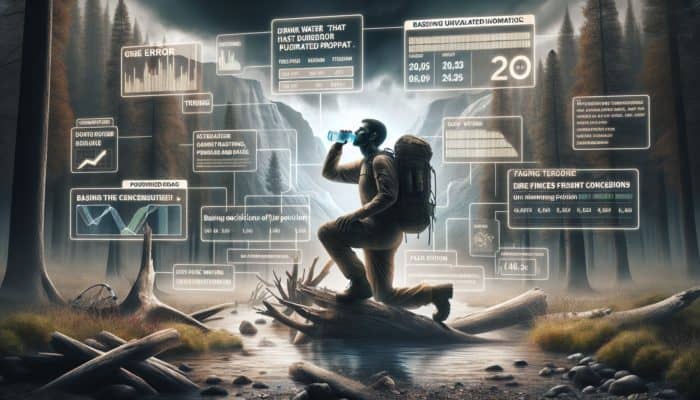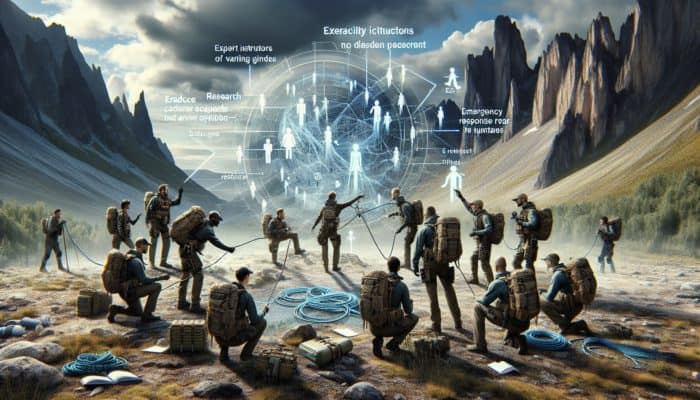Understanding the Risks of Misinformation in Survival Scenarios
How Can Misinformation Result in Life-Threatening Decisions?

Survival Myths Debunked: Misinformation poses a significant threat in survival situations, leading individuals to make critical errors in judgment that can drastically increase their risk of injury or even death. In high-pressure environments where decisions must be made swiftly, adhering to false information can severely impede effective responses. For example, an individual might mistakenly use an incorrect method to purify water, believing it to be reliable because of myths. This can result in serious health complications. The potential repercussions highlight the vital need for accurate and reliable survival knowledge.
Some prevalent instances of misinformation include:
- Assuming that drinking urine is a safe method of hydration.
- Believing that moss exclusively grows on the north side of trees.
- Thinking that starting a fire is as simple as striking a match.
- Believing that all wild mushrooms are safe to eat.
- Thinking that survival is possible indefinitely without food.
- Assuming wild animals will consistently avoid human contact.
- Thinking that signalling for help is futile in remote areas.
- Believing that using a compass is instinctive and does not require practice.
Recognising these dangers is crucial for ensuring safety and effective survival training. It encourages individuals to pursue verified information and develop skills that can profoundly impact outcomes during emergencies.
The Influence of Media on the Propagation of Survival Myths
Media significantly shape public perceptions of survival strategies, often sensationalising stories for entertainment. This sensationalism can propagate myths, leading to a skewed understanding of survival scenarios. By dramatizing events, the media can create unrealistic expectations about the ease of survival, which can prove detrimental when individuals find themselves in genuine emergencies and lack the requisite skills or knowledge.
Common media myths often include:
- The belief that survivors can effortlessly find food and water in the wild.
- The perception is that only unprepared individuals face challenges in survival situations.
- Assuming that a knife is the sole tool necessary for survival.
- Believing that survival is entirely reliant on physical strength.
- The notion that emergency shelters can be erected in mere minutes.
- Thinking that wild animals are always dangerous and should be avoided at all costs.
- Assuming that a single survival manual suffices for every possible scenario.
- Believing that intuition alone is sufficient for navigation and foraging.
By understanding the media's role in perpetuating these myths, individuals can cultivate a more realistic view of survival scenarios, focusing on preparation and skill development rather than sensationalised narratives.
Effective Strategies to Counter Misinformation
To effectively counter misinformation, individuals must take a proactive stance towards their survival education. This journey begins with education—gaining an understanding of survival facts through reputable sources. Developing critical thinking skills is vital for assessing available information, enabling individuals to distinguish between myth and fact. Furthermore, relying on verified resources, such as expert-led courses or respected survival literature, equips individuals with the essential knowledge needed to navigate emergencies successfully.
Practical strategies include:
- Participating in hands-on survival training.
- Consulting with experts in the field to obtain accurate information.
- Cross-referencing information from multiple sources before accepting it as fact.
- Joining local community workshops that focus on survival skills.
- Following reputable organisations dedicated to survival education.
- Utilising technology and apps specifically designed for survival training.
- Staying informed about discoveries and techniques in survival methods.
- Engaging in discussions about survival topics within groups to share and verify information.
By adopting these strategies, individuals can enhance their preparedness and foster a mindset grounded in reality, ultimately improving survival outcomes.
Expert Opinions on Debunking Survival Myths

How Do Experts Distinguish Between Survival Myths and Facts?
Experts discern survival myths through extensive analysis and empirical data evaluation. They employ scientific methodologies to differentiate between widely held beliefs and factual evidence. This process often involves conducting experiments, examining case studies, and gathering insights from survivors of real-life situations. Experts engage in systematic research to identify why certain myths endure and how they can be effectively debunked, offering a clearer understanding of survival tactics.
To identify myths, experts take actionable steps such as:
- Conducting field tests to validate survival techniques.
- Reviewing historical case studies of various survival scenarios.
- Collaborating with other experts to share insights and findings.
- Surveying individuals who have faced survival situations for their perspectives.
- Monitoring the rise of new myths through media and social platforms.
- Regularly updating guidelines based on the latest research.
- Educating the public on the critical importance of critical thinking in survival.
- Publishing findings in reputable survival and outdoor magazines.
These processes help establish an evidence-based understanding of survival practices, which is essential for effective training and preparation.
What Are the Most Frequently Encountered Survival Myths?
Survival myths are widespread and can lead individuals to make perilous decisions during critical situations. Among the most commonly believed myths is the notion that drinking urine can provide effective hydration, or that moss grows exclusively on the north side of trees, misleading individuals about navigation and resource identification. Such misconceptions can have catastrophic consequences, especially in life-or-death situations where precise knowledge is of utmost importance.
Common survival myths encompass:
- Drinking urine is safe and can hydrate effectively.
- All plants are safe to forage for food without risk.
- Starting a fire is easy with any dry material.
- Wild animals will approach humans out of curiosity.
- Surviving indefinitely without food is possible.
- Every injury can be managed with basic first aid.
- Survivors should always remain stationary rather than seeking help.
- Heat escapes solely from the head, making covering it adequate for warmth.
Grasping these myths is crucial for effective survival training, as it empowers individuals to learn the truth about survival tactics and prepares them for real-world applications.
The Significance of Expert Endorsement in Survival Training

Expert endorsement is vital in survival training, ensuring that the information presented is grounded in reality and supported by research. Having credible sources and experienced instructors enhances the reliability of survival education, allowing individuals to cultivate confidence in their skills. This approach also promotes a culture of preparedness, equipping learners with the knowledge essential for effective responses during emergencies.
Expert endorsement encompasses:
- Utilising research-based curricula that reflect the latest survival techniques.
- Incorporating feedback from real-world experiences into training programmes.
- Maintaining current knowledge through continuous professional development.
- Forming partnerships with organisations specialising in wilderness education.
- Encouraging instructor-led workshops with seasoned survival experts.
- Creating opportunities for practical, hands-on learning experiences.
- Implementing certification programmes to ensure instructors meet high standards.
- Engaging participants in discussions regarding myth identification and debunking.
By prioritising expert endorsement in survival training, communities can nurture a more informed and prepared populace, capable of addressing emergencies with confidence and skill.
Crucial Survival Skills and the Myths Surrounding Them
How to Effectively Build a Fire in Various Conditions
Constructing a fire is a fundamental survival skill that provides warmth, protection, and a means to cook food. However, numerous myths surround the simplicity of starting fires, often leading individuals to underestimate the level of skill required. Different environments present unique challenges, and understanding these conditions is crucial for success. For instance, attempting to start a fire in damp conditions requires additional techniques and preparation than in drier settings.
Common myths associated with fire-starting include:
- Believing that one match or lighter is sufficient in all circumstances.
- Assuming that all types of wood can be used interchangeably.
- Thinking that a fire can be built anywhere without considering the surroundings.
- Believing that once a fire is ignited, it requires no further management.
- Thinking that any dry material found in the wild can be used for kindling.
- Believing that fires can be started solely by friction using any two sticks.
- Assuming that building a fire is always safe and poses no risk of wildfires.
- Thinking that having a fire starter kit is unnecessary if one has experience.
Understanding the proper techniques for building a fire under various conditions can significantly increase the likelihood of success—and survival. Mastering various methods, such as teepee, log cabin, or lean-to structures, improves adaptability and ensures a reliable fire source.
The Truth About Water Sourcing and Purification Techniques
Water is essential for survival; however, numerous myths persist about how to obtain and purify it. Misunderstandings about these processes can lead to severe health risks, particularly in survival situations where access to clean water is restricted. Understanding how to identify safe water sources and the most effective purification methods is vital. For instance, many believe that boiling water is the only reliable method of purification, overlooking other effective techniques.
Common myths regarding water sourcing and purification include:
- Assuming that drinking straight from rivers and lakes is safe.
- Believing that all rainwater is safe for consumption without purification.
- Thinking that filtering water through a cloth is adequate for purification.
- Assuming that water from urban areas is always contaminated.
- Believing that all portable water filters offer the same level of effectiveness.
- Thinking that ice can be safely consumed without melting first.
- Assuming that water can be easily sourced by digging in wet soil.
- Believing that boiling is the only reliable method of purification.
Grasping the realities of water sourcing and purification techniques can prevent illness and ensure adequate hydration. Techniques such as solar distillation and chemical tablets can complement boiling, providing viable options for clean drinking water in emergencies.
Shelter Building: Distinguishing Fact from Fiction
Constructing a shelter is essential for protection against environmental elements, yet many myths misrepresent the simplicity of building adequate structures. These misconceptions can lead individuals to attempt to construct shelters that ultimately fail to provide safety or comfort. Understanding the appropriate materials and methods for shelter construction can greatly influence survival success, especially in extreme weather conditions.
Common myths about shelter building include:
- Assuming that any overhead cover is adequate for protection.
- Believing that constructing a shelter requires extensive tools and materials.
- Thinking that it is feasible to build a shelter in any location without prior planning.
- Believing that all shelters can be built quickly without prior knowledge.
- Thinking that natural materials like leaves and branches can always provide insulation.
- Believing that as long as there is a roof, one is safe from the elements.
- Assuming that only large shelters offer adequate protection.
- Thinking that emergency blankets suffice for warmth in cold conditions.
By discerning fact from fiction in shelter building, individuals can learn to prioritise location, structure type, and material use. Knowledge of various shelter designs—such as A-frames, lean-tos, or debris huts—can enhance adaptability and improve overall survival chances.
Mastering Navigation with a Compass and Map: Debunking Common Myths
Effective navigation can be the difference between safety and disorientation; yet, many myths surround the proper use of compasses and maps. Misguided beliefs about navigation tools can lead individuals into perilous situations, particularly in unfamiliar territories. Understanding how to utilise these tools correctly is essential for successful navigation and identifying safe routes to safety.
Common myths regarding compass and map usage include:
- Believing that maps are unnecessary as long as a compass is available.
- Assuming that using a compass requires no prior knowledge or practice.
- Thinking that one can rely solely on landmarks for navigation.
- Believing that compasses are accurate in all environments.
- Assuming that north is consistent in every location, irrespective of magnetic declination.
- Thinking that navigating by intuition alone is effective.
- Believing that reading a map is straightforward and requires no skills.
- Assuming that the sun can always serve as a reliable compass substitute.
Understanding the realities of navigation with a compass and a map can prevent individuals from becoming lost or disoriented. Learning how to interpret topographical maps, identify key features, and understand magnetic declination are essential skills for any outdoor enthusiast.
Foraging for Food: Distinguishing Fact from Fiction
Foraging for food can appear appealing in survival scenarios, yet myths surrounding edible plants and animals can pose significant dangers. Misidentifying plants or erroneously believing that wildlife can be easily hunted can lead to perilous outcomes. A comprehensive understanding of local flora and fauna, along with the skills to identify safe food sources, is imperative for survival.
Common foraging myths include:
- Believing that all wild plants are edible if cooked properly.
- Assuming animals can be hunted without specific skills or equipment.
- I think that identifying edible mushrooms is straightforward with a few basic guidelines.
- Believing that foraging guarantees food availability in the wild.
- Assuming only experts can accurately identify edible plants.
- Thinking that cooking eliminates all toxins from wild food sources.
- Believing that foraging can replace traditional food sources without prior planning.
- Assuming that all berries found in the wild are safe to consume.
By distinguishing truth from fiction in foraging, individuals can develop a broader understanding of safe food sourcing. Engaging in local workshops, studying field guides, and practising hands-on identification skills can enhance preparedness and mitigate the risk of food-related health concerns.
How Do Survival Myths Influence Long-Term Mental Preparedness?
How Do Myths Impact Mental Readiness?
Survival myths can profoundly affect psychological well-being, influencing mental preparedness and emotional resilience. Embracing these myths can lead to either false confidence or debilitating fear, both of which can obstruct effective decision-making in survival situations. Recognising these psychological impacts enables individuals to cultivate a more realistic mindset, enhancing their capacity to cope during emergencies.
The influence of myths on mental preparedness can manifest in various ways. For example, an individual may feel overconfident about their survival skills based on misleading information, leading them to take unwarranted risks. Conversely, the fear instilled by myths can induce anxiety, causing individuals to freeze in critical moments. By acknowledging these effects, individuals can work to mitigate their influence.
Common effects of myths on mental preparedness include:
- Creating unrealistic expectations regarding survival capabilities.
- Instilling fear of the unknown, leading to panic.
- Fostering a sense of overconfidence in untested abilities.
- This leads to the avoidance of acquiring important survival techniques.
- Contributing to a defeatist attitude in challenging circumstances.
- This leads to dependence on myths rather than practical knowledge.
- Reducing individual motivation to practise survival skills.
- Encouraging the dissemination of misinformation within communities.
By addressing these psychological effects, individuals can develop greater mental resilience and preparedness, enabling more effective responses during survival situations.
The Role of Fear and Panic in Survival Scenarios
Fear and panic are natural responses in survival situations, yet myths can exacerbate these emotions, often resulting in poor decision-making. Misunderstandings about survival can create an atmosphere of distress, making it difficult for individuals to think clearly and act decisively. Learning how to manage these emotions is critical for achieving survival success.
The role of fear can manifest in various ways. For example, individuals may panic when confronted with unexpected challenges, such as encountering wildlife or navigating unfamiliar terrain. This panic can lead to hasty decisions, often resulting in further complications or dangerous situations. Understanding how myths contribute to fear can empower individuals to face these emotions with confidence.
Strategies for managing fear and panic include:
- Practising mindfulness and grounding techniques.
- Engaging in realistic training scenarios to build confidence.
- Learning breathing exercises to calm the mind.
- Developing a clear action plan for emergencies.
- Seeking support from peers or mentors during training.
- Educating oneself about potential survival scenarios to diminish fear of the unknown.
- Reflecting on previous successful experiences to instill confidence.
- Understanding that fear is a normal response in critical situations.
By focusing on these strategies, individuals can better manage fear and panic, thereby enhancing their chances of effective decision-making during survival scenarios.
Techniques for Overcoming Psychological Barriers
Overcoming psychological barriers is essential for individuals to prepare for survival scenarios adequately. These barriers may arise from fear, misinformation, or a lack of confidence in one’s abilities. By addressing these psychological challenges, individuals can build resilience and enhance their mental preparedness for emergencies.
Effective strategies for combating these psychological barriers include:
- Engaging in regular training to develop practical skills.
- Participating in group discussions to share experiences and insights.
- Setting realistic goals for survival training and practice.
- Utilising visualization techniques to prepare for scenarios mentally.
- Seeking feedback from peers and experts to refine skills.
- Building a support network of fellow learners for encouragement.
- Practising stress management techniques, such as meditation.
- Educating oneself about the psychological aspects of survival.
By employing these strategies, individuals can cultivate greater psychological resilience, equipping themselves to face challenges in survival situations with confidence and clarity.
The Long-Term Psychological Effects of Survival Myths
Persistently believing in survival myths can lead to long-term psychological effects, resulting in chronic anxiety and stress. These issues can impact an individual’s overall mental health and resilience, as the fear of potential survival situations may create a constant state of worry. Understanding the connection between myths and psychological health is vital for fostering a positive mindset.
The long-term effects of myths can manifest in various ways. Individuals may develop an exaggerated fear of being unprepared, leading to an unhealthy preoccupation with survival scenarios. This chronic anxiety can disrupt daily life, affecting personal relationships and overall well-being. By debunking myths and acquiring accurate knowledge, individuals can alleviate these psychological burdens.
Common long-term effects of survival myths include:
- Increased anxiety and stress related to survival preparedness.
- Development of avoidance behaviours towards outdoor activities.
- Decreased confidence in managing emergencies.
- Difficulty in making decisions under pressure.
- Chronic fear of the unknown affects daily activities.
- Negative impacts on personal relationships due to stress.
- Potential for developing phobias related to survival scenarios.
- Difficulty in enjoying nature and outdoor experiences.
By understanding these long-term effects, individuals can strive to cultivate a healthier mindset, prioritising accurate knowledge over myths, ultimately enhancing their psychological resilience.
Research-Backed Advantages of Debunking Survival Myths
What Insights Does Research Provide on the Benefits of Debunking Myths?
Research consistently shows that debunking survival myths significantly improves outcomes for individuals facing emergencies. By promoting accurate knowledge and practical skills, individuals become better prepared, ultimately increasing their chances of survival. The relationship between myth debunking and successful survival outcomes underscores the necessity for proper education and training in survival techniques.
Expert analysis indicates that when individuals engage with factual information, they are more likely to make informed decisions in crises. This connection between knowledge and action is crucial, as it reflects the importance of preparedness. Furthermore, studies reveal that communities prioritising accurate survival education are better equipped to respond to emergencies, highlighting the collective advantages of myth debunking.
Key findings on the benefits of debunking myths include:
- Improved decision-making in crises.
- Enhanced confidence in survival skills.
- Increased community preparedness and resilience.
- Reduced reliance on misinformation and myths.
- Better understanding of basic survival principles.
- Lower incidences of panic and fear during emergencies.
- Greater willingness to engage in survival training and education.
- Positive psychological impacts leading to improved mental health.
By embracing research on myth debunking, individuals and communities can bolster their overall preparedness and effectiveness in survival scenarios.
The Role of Education in Improving Survival Rates
Education plays a crucial role in debunking myths and teaching effective survival skills. As individuals acquire knowledge of survival techniques and accurate information, their preparedness improves, resulting in higher survival rates in emergencies. The link between education and survival outcomes illustrates the significance of nurturing a culture of learning in survival training contexts.
Effective educational programmes focus on hands-on learning, critical thinking, and real-world applications. These programmes not only debunk myths but also empower individuals to take responsibility for their preparedness. By teaching individuals how to assess situations, gather resources, and make informed decisions, education enhances their ability to respond effectively during crises.
Key aspects of the role of education in survival include:
- Providing practical skills through hands-on training.
- Encouraging critical thinking and decision-making strategies.
- Fostering collaboration and knowledge-sharing among learners.
- Creating opportunities for practice in realistic scenarios.
- Promoting continuous learning and adaptation to new techniques.
- Enhancing community engagement in survival education.
- Emphasising the importance of verifying information sources.
- Building confidence through successful training experiences.
By prioritising education in survival training, individuals and communities can cultivate a more prepared and resilient populace, capable of facing emergencies with skill and knowledge.
How Can Accurate Information Prove Life-Saving?
Accurate information can play a vital role in survival situations, empowering individuals to make informed decisions that enhance their chances of survival. When individuals have access to reliable knowledge and skills, they are better equipped to navigate emergencies effectively. Understanding how to leverage this information is crucial for achieving successful outcomes.
In critical scenarios, having accurate information enables individuals to assess their surroundings, identify resources, and implement effective strategies. For instance, knowing the proper methods to purify water or construct a shelter can significantly impact survival chances. By equipping individuals with factual knowledge, communities can foster an environment of preparedness that ultimately saves lives.
Key aspects of how accurate information saves lives include:
- Facilitating informed decision-making in emergencies.
- Reducing reliance on myths and misconceptions.
- Enhancing the ability to assess risks and take appropriate actions.
- Providing knowledge of available resources and their usage.
- Encouraging proactive planning and preparation.
- Building confidence in survival skills and techniques.
- Facilitating effective communication during emergencies.
- Enhancing community resilience through shared knowledge.
By acknowledging the life-saving potential of accurate information, individuals can prioritise education and training that fosters a culture of informed preparedness within their communities.
How Do Survival Myths Impact Long-Term Preparedness?
The Effects of Myths on Emergency Planning
Survival myths can severely undermine effective emergency planning, leading individuals to depend on false information and neglect crucial preparedness strategies. When individuals hold misconceptions about survival, they may fail to develop comprehensive plans that address genuine risks and challenges. This lack of preparedness can have dire consequences in real emergencies, underscoring the importance of accurate knowledge in planning.
Myths can distort perceptions of what is necessary for effective preparedness. For example, believing that one can rely solely on instinct during emergencies may lead to subpar planning and skill development. Consequently, individuals may fail to engage in essential training or resource gathering, thereby compromising their safety in critical situations.
Key impacts of myths on emergency planning include:
- Encouraging complacency and overconfidence.
- This leads to inadequate training and skill acquisition.
- Contributing to the failure to recognise potential hazards.
- Disregarding the need for a comprehensive emergency kit.
- Neglecting to create a clear communication plan for emergencies.
- Undermining the importance of community collaboration.
- Overlooking the significance of ongoing education and practice.
- Creating a false sense of security regarding survival capabilities.
By addressing the impact of myths on emergency planning, individuals can develop more effective strategies that prioritise accurate information and preparedness.
Fostering a Culture of Preparedness
Creating a culture of preparedness involves nurturing an environment where individuals prioritise survival education and actively debunk myths. This cultural shift encourages communities to engage in continuous learning, skill development, and resource gathering, cultivating a more resilient populace. By emphasising preparedness, individuals are better equipped to manage emergencies and support one another during crises.
Promoting a culture of preparedness necessitates collaboration and shared responsibility. Community organisations, educational institutions, and local leaders can play a pivotal role in providing resources and training opportunities. By implementing workshops, training programmes, and public awareness campaigns, communities can foster a culture that values preparedness and knowledge.
Key components of building a culture of preparedness include:
- Encouraging community-wide training and workshops.
- Creating accessible resources for survival education.
- Fostering open discussions about survival myths and realities.
- Promoting collaboration among local organisations and experts.
- Utilising social media to disseminate knowledge and experiences.
- Incorporating survival education into school curricula.
- Recognising and celebrating community preparedness efforts.
- Encouraging individuals to take personal responsibility for their preparedness.
By prioritising a culture of preparedness, communities can enhance their resilience, ensuring that individuals are equipped to handle emergencies with confidence and skill.
What Are the Long-Term Advantages of Debunking Myths?
Debunking survival myths yields numerous long-term benefits, ultimately creating a more prepared and knowledgeable community. When individuals engage with accurate information, their understanding of survival strategies improves, enhancing their confidence and skills. This shift in mindset fosters a culture of preparedness, empowering individuals to act decisively in emergencies.
The long-term benefits of myth debunking extend beyond individual preparedness. Communities that prioritise accurate survival education experience increased resilience, as members are better equipped to support one another during crises. This collective knowledge-sharing can lead to improved emergency response, ultimately saving lives and minimising the impact of disasters.
Key long-term benefits of myth debunking include:
- Improved individual decision-making during emergencies.
- Enhanced community collaboration and support networks.
- Greater resilience to unexpected challenges.
- Reduced dependence on misinformation and myths.
- Increased engagement in survival training and education.
- Strengthened mental health and confidence among community members.
- Development of comprehensive emergency plans.
- Promotion of ongoing learning and adaptation in survival practices.
By embracing the benefits of myth debunking, individuals and communities can cultivate a more prepared environment, ultimately enhancing their chances of survival in emergencies.
Reliable Strategies for Debunking Survival Myths
How to Validate Survival Information
Validating survival information is essential for ensuring the accuracy and reliability of the knowledge individuals depend on in emergencies. By checking multiple sources and consulting with experts, individuals can distinguish between myths and facts, enhancing their preparedness. This process requires critical thinking and a proactive approach to information gathering.
Real-world validation processes may involve comparing information from reputable books, websites, and expert-led courses. Engaging with experienced practitioners and communities can also provide valuable insights, aiding in the verification of survival techniques. Additionally, attending local workshops or training sessions allows individuals to observe techniques in action and ask questions, further solidifying their understanding.
Effective strategies for validating survival information include:
- Cross-referencing multiple reliable sources before accepting information.
- Consulting experts in survival training for clarification and guidance.
- Engaging in community discussions and knowledge-sharing platforms.
- Participating in practical training to observe techniques firsthand.
- Keeping updated with the latest research in survival practices.
- Utilising technology, such as apps, that provide vetted information.
- Creating a network of knowledgeable individuals for support and verification.
- Maintaining a critical mindset when assessing new survival claims.
By implementing these strategies, individuals can bolster their ability to validate survival information, ensuring they are equipped with accurate knowledge for emergencies.
The Importance of Lifelong Learning in Survival Preparedness
Lifelong learning is vital for individuals to stay informed about the latest survival techniques and effectively dispel myths. The landscape of survival education is continually evolving, with new research and practices emerging regularly. By actively engaging in ongoing learning, individuals can enhance their skills, improve their preparedness, and cultivate a growth-oriented mindset.
Engaging in continuous education can include attending workshops, participating in online courses, reading recent literature, and joining community groups dedicated to survival skills. This commitment to learning ensures that individuals remain informed about best practices and can adapt to new challenges as they arise. Moreover, sharing knowledge with others fosters a community of learning that benefits everyone involved.
Key aspects of continuous learning in survival include:
- Participating in regular training sessions and workshops.
- Staying updated on new survival resources and techniques.
- Networking with other survival enthusiasts to share knowledge.
- Reflecting on personal experiences to identify areas for improvement.
- Engaging with online forums to discuss survival strategies.
- Following experts on social media for insights and updates.
- Reading books and articles on the latest survival research.
- Emphasising the importance of adaptability in survival practices.
By prioritising continuous learning, individuals can enhance their survival skills and knowledge, ultimately fostering a culture of preparedness within their communities.
What Are the Optimal Practices for Survival Training?
Optimal practices for survival training encompass a range of strategies that ensure individuals receive comprehensive and effective education. Effective training programmes focus on practical, hands-on learning, allowing participants to develop and refine their skills. Engaging in scenario-based learning also prepares individuals to respond effectively during real-world emergencies.
Key practices for effective survival training include:
- Utilising hands-on training to facilitate skill development.
- Incorporating scenario-based learning to simulate real-life situations.
- Maintaining updated curricula that reflect the latest research.
- Encouraging peer collaboration and knowledge sharing during training.
- Implementing regular practice sessions to reinforce learned skills.
- Seeking feedback from experienced instructors to improve techniques.
- Emphasising the importance of adaptability and problem-solving skills.
- Creating opportunities for community involvement and support.
By adhering to these best practices, survival training programmes can enhance their effectiveness, equipping individuals with the knowledge and skills necessary to navigate emergencies confidently.
The Impact of Technology on Debunking Survival Myths
How Has Technology Enhanced Survival Knowledge?
Technology has transformed the way individuals access and share survival knowledge. With the internet, social media, and mobile applications, vast amounts of information are now readily available, making it easier to debunk myths and promote accurate survival techniques. This accessibility enables individuals to learn from experts and peers, fostering a more informed community.
Digital platforms allow users to engage in discussions, share experiences, and critique common survival beliefs, enhancing collective understanding. Online courses and video tutorials offer visual learning opportunities, enabling individuals to witness techniques demonstrated in real time. Additionally, technology facilitates the dissemination of new research, ensuring that survival education remains current and evidence-based.
Key improvements in survival knowledge through technology include:
- Access to extensive online resources, including articles and videos.
- Opportunities for virtual training and workshops.
- Engagement with expert-led forums and discussions.
- Real-time updates on best practices and survival techniques.
- Utilisation of apps that offer guidance on various survival skills.
- Increased collaboration among survival enthusiasts via social media.
- Enhanced ability to verify information through multiple sources.
- Tools for documenting personal experiences and sharing lessons learned.
By leveraging technology, individuals can enhance their survival knowledge and skills, ultimately fostering a more equipped and informed community.
The Utilisation of Apps and Online Resources for Survival Training
Apps and online resources have emerged as invaluable tools for survival training, providing individuals with easy access to critical information and practical skills. These resources offer a wide array of training options, from step-by-step guides to interactive learning experiences. Incorporating technology into survival education enhances accessibility and engagement, helping individuals develop essential skills more effectively.
Survival apps often feature elements such as offline access, instructional videos, and community forums, creating a comprehensive learning environment. Online platforms enable users to participate in courses, access expert insights, and engage with other learners, promoting collaboration and knowledge sharing. Furthermore, these resources are frequently updated, ensuring that individuals stay informed about the latest survival practices.
Key benefits of using apps and online resources for survival training include:
- Accessible information anytime and anywhere, even offline.
- Engaging multimedia content that enhances learning experiences.
- Opportunities for collaboration and knowledge sharing within communities.
- Regular updates on best practices and new techniques.
- Interactive features that promote hands-on learning.
- Access to expert insights and real-world experiences.
- Tracking progress and setting learning goals.
- Encouraging continuous learning and skill development.
By integrating apps and online resources into survival training, individuals can enhance their preparedness and confidence in navigating emergencies.
The Future of Technology in Survival Education
The future of survival education is set to incorporate advanced technologies, such as virtual reality (VR) and augmented reality (AR), which can dramatically enrich learning experiences. These technologies offer immersive training environments where individuals can practise survival skills in realistic scenarios without the risks associated with live practice. As these tools become increasingly accessible, they will play a critical role in preparing individuals for emergencies.
Virtual reality simulations provide learners with opportunities to experience various survival situations, aiding the development of critical thinking and decision-making skills. Additionally, augmented reality can offer real-time guidance during outdoor activities, ensuring that individuals have access to accurate information as they navigate unfamiliar environments. This integration of technology into survival training can bridge the gap between theory and practice, enhancing overall preparedness.
Key trends for the future of technology in survival education include:
- Increased access to virtual reality training environments.
- Integration of augmented reality for real-time navigation assistance.
- Development of AI-driven apps that tailor training to individual needs.
- Enhanced collaboration through online platforms and communities.
- Utilisation of gamification to engage learners in survival skills.
- Focus on personalised learning experiences for skill acquisition.
- Real-time data collection for feedback on training effectiveness.
- Emphasis on continuous updates to reflect the latest survival research.
By embracing these technological advancements, the future of survival education will become more effective, engaging, and relevant, ultimately improving the preparedness of individuals and communities worldwide.
Frequently Asked Questions
What are some prevalent survival myths?
Common survival myths include the belief that drinking urine can provide hydration, that moss grows only on the north side of trees, and that one can survive indefinitely without food. These myths can lead to poor decision-making in critical situations.
How can misinformation affect survival situations?
Misinformation can lead individuals to make hazardous choices in survival scenarios, increasing the risk of injury or death. It can create a false sense of confidence or instill fear, impacting mental readiness.
What role does the media play in perpetuating survival myths?
The media often sensationalises survival stories, distorting public understanding and preparedness. This can result in the spread of inaccurate beliefs about survival techniques.
How can I verify survival information?
Validate survival information by cross-referencing multiple reliable sources, consulting experts, and engaging in hands-on training to observe techniques firsthand.
What are the psychological effects of believing in survival myths?
Believing in survival myths can lead to chronic anxiety, fear of the unknown, and overconfidence in untested skills, ultimately hindering effective decision-making during emergencies.
Why is education pivotal in survival training?
Education enhances survival skills and knowledge, thereby improving preparedness and increasing survival rates. It empowers individuals to make informed decisions during emergencies.
What effective strategies exist for overcoming psychological barriers in survival?
Effective strategies include engaging in realistic training scenarios, practising mindfulness, and setting achievable goals for skill development to build confidence and resilience.
How can technology improve survival training?
Technology enhances survival training by providing access to extensive resources, facilitating online learning, and enabling real-time updates on best practices and survival techniques.
What best practices should be followed for survival training?
Best practices entail hands-on training, scenario-based learning, regular practice, and seeking feedback from experienced instructors to enhance skill development.
What are the benefits of debunking survival myths?
Debunking survival myths leads to greater individual and community preparedness, improved decision-making during emergencies, and enhanced confidence in survival skills.
Explore more with us on X!
Survival Leadership Roles for Effective Crisis Management
Essential Survival Leadership Roles: Mastering Crisis Management Understanding the Dynamics of Survival Leadership Roles Grasping the intricacies of survival leadership roles is vital for anyone responsible for steering a team through challenging crises. These roles encompass a broad spectrum of duties, prominently revolving around effective decision-making, robust communication, and strategic planning. Central to the essence […]



